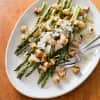Selecting Thick vs. Thin of Asparagus
Sometimes the asparagus stalks at local markets are as thin as pencils; other times they’re fat and meaty. Is thickness an indication of maturity? And does size affect taste?
Asparagus spears are the plant shoots of an underground crown that can produce for up to 20 years. The thickness of a spear has nothing to do with its age—that is, a thin spear will not mature into a thicker spear. Rather, diameter is determined by two factors: the age of the entire plant (younger crowns produce more slender stalks) and its variety.
So, which size is preferable? We snapped off the woody bottoms of fat and skinny spears and tasted them side by side, both steamed and tossed with olive oil and salt. While both types tasted equally sweet, nutty, and grassy, we expected the delicate-looking thin spears to be more tender. To our surprise, the thicker spears actually had the better texture (if only by a hair). The reason? The vegetable’s fiber is slightly more concentrated in thinner spears.
Since thick and thin spears are both good bets, choose the size that best suits your cooking method. Thicker stalks are better for broiling and roasting because they will stand up to the intense dry heat that would quickly shrivel skinnier spears. We also like thicker spears for grilling since they are easier to manipulate. Quick-cooking thinner spears are good candidates for steaming and stir-frying.

